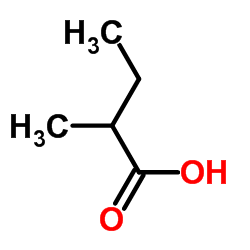2-Methylbutyric acid

2-Methylbutyric acid structure
|
Common Name | 2-Methylbutyric acid | ||
|---|---|---|---|---|
| CAS Number | 116-53-0 | Molecular Weight | 102.132 | |
| Density | 1.0±0.1 g/cm3 | Boiling Point | 175.3±8.0 °C at 760 mmHg | |
| Molecular Formula | C5H10O2 | Melting Point | -70ºC | |
| MSDS | Chinese USA | Flash Point | 73.9±0.0 °C | |
| Symbol |


GHS05, GHS07 |
Signal Word | Danger | |
|
Combined effects of nutrients and temperature on the production of fermentative aromas by Saccharomyces cerevisiae during wine fermentation.
Appl. Microbiol. Biotechnol. 99(5) , 2291-304, (2015) Volatile compounds produced by yeast during fermentation greatly influence the organoleptic qualities of wine. We developed a model to predict the combined effects of initial nitrogen and phytosterol content and fermentation temperature on the production of v... |
|
|
GC/MS method for determining carbon isotope enrichment and concentration of underivatized short-chain fatty acids by direct aqueous solution injection of biogas digester samples.
Talanta 143 , 56-63, (2015) In anaerobic digestion of organic matter, several metabolic pathways are involved during the simultaneous production and consumption of short-chain fatty acids (SCFA) in general and acetate in particular. Understanding the role of each pathway requires both t... |
|
|
Structural variation governs substrate specificity for organic anion transporter (OAT) homologs. Potential remote sensing by OAT family members.
J. Biol. Chem. 282 , 23841-53, (2007) Organic anion transporters (OATs, SLC22) interact with a remarkably diverse array of endogenous and exogenous organic anions. However, little is known about the structural features that determine their substrate selectivity. We examined the substrate binding ... |
|
|
Using contemporary liquid chromatography theory and technology to improve capillary gradient ion-exchange separations.
J. Chromatogr. A. 1370 , 63-9, (2014) The gradient-performance limits of capillary ion chromatography have been assessed at maximum system pressure (34.5 MPa) using capillary columns packed with 4.1 μm macroporous anion-exchange particles coated with 65 nm positively-charged nanobeads. In analogy... |
|
|
Circuit formation and function in the olfactory bulb of mice with reduced spontaneous afferent activity.
J. Neurosci. 35(1) , 146-60, (2015) The type of neuronal activity required for circuit development is a matter of significant debate. We addressed this issue by analyzing the topographic organization of the olfactory bulb in transgenic mice engineered to have very little afferent spontaneous ac... |
|
|
Direct Derivatization vs Aqueous Extraction Methods of Fecal Free Fatty Acids for GC-MS Analysis.
Lipids 50 , 681-9, (2015) A comprehensive and accurate determination of free fatty acids (FFA) is required for fecal metabolomic investigations. The present study compares three aqueous extraction methods (1) ULTRA-TURRAX(®), (2) whirl mixing and (3) basic ULTRA-TURRAX extraction of f... |
|
|
Application of integrated comprehensive/multidimensional gas chromatography with mass spectrometry and olfactometry for aroma analysis in wine and coffee.
Food Chem. 185 , 355-61, (2015) Component coelution in chromatographic analysis complicates identification and attribution of individual odour-active volatile molecules in complex multi-component samples. An integrated system incorporating comprehensive two-dimensional gas chromatography (G... |
|
|
Correlating wine quality indicators to chemical and sensory measurements.
Molecules 20 , 8453-83, (2015) Twenty-seven commercial Californian Cabernet Sauvignon wines of different quality categories were analyzed with sensory and chemical methods. Correlations between five quality proxies-points awarded during a wine competition, wine expert scores, retail price,... |
|
|
BACE1 and cholinesterase inhibitory activities of Nelumbo nucifera embryos.
Arch. Pharm. Res. 38 , 1178-87, (2015) The aim of the present study was to evaluate the comparative anti-Alzheimer's disease (AD) activities of different parts of Nelumbo nucifera (leaves, de-embryo seeds, embryos, rhizomes, and stamens) in order to determine the selectivity and efficient use of i... |
|
|
Requirements for the formation of a chiral template.
J. Phys. Chem. B 109(2) , 851-6, (2005) The chemisorptive enantioselectivity of propylene oxide is examined on Pd(111) surfaces templated by chiral 2-methylbutanoate and 2-aminobutanoate species. It has been found previously that chiral propylene oxide is chemisorbed enantiospecifically onto Pd(111... |